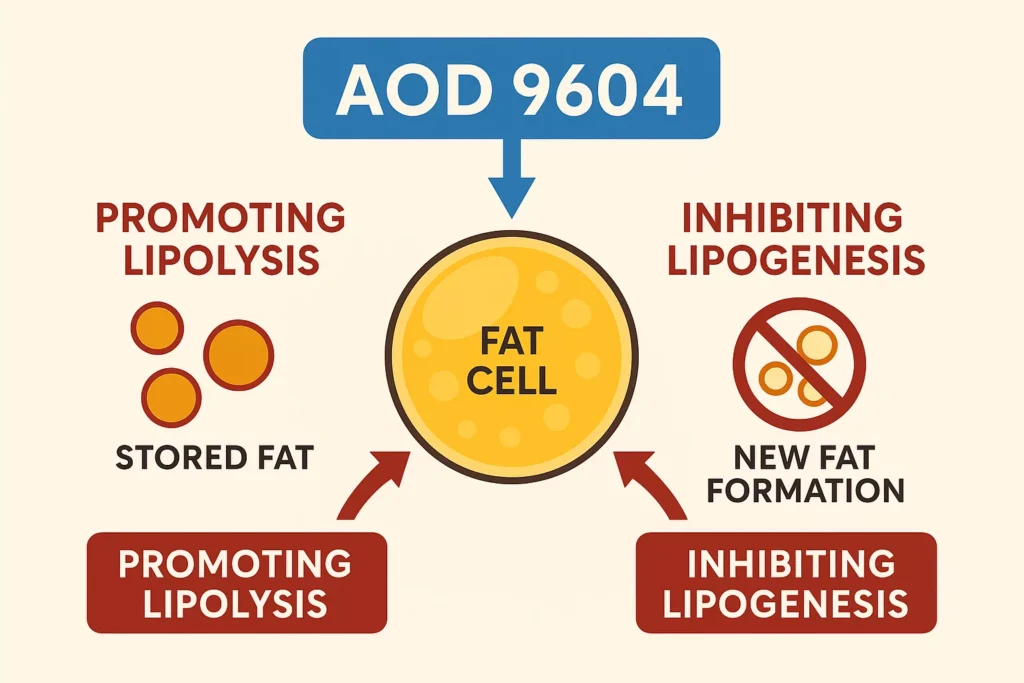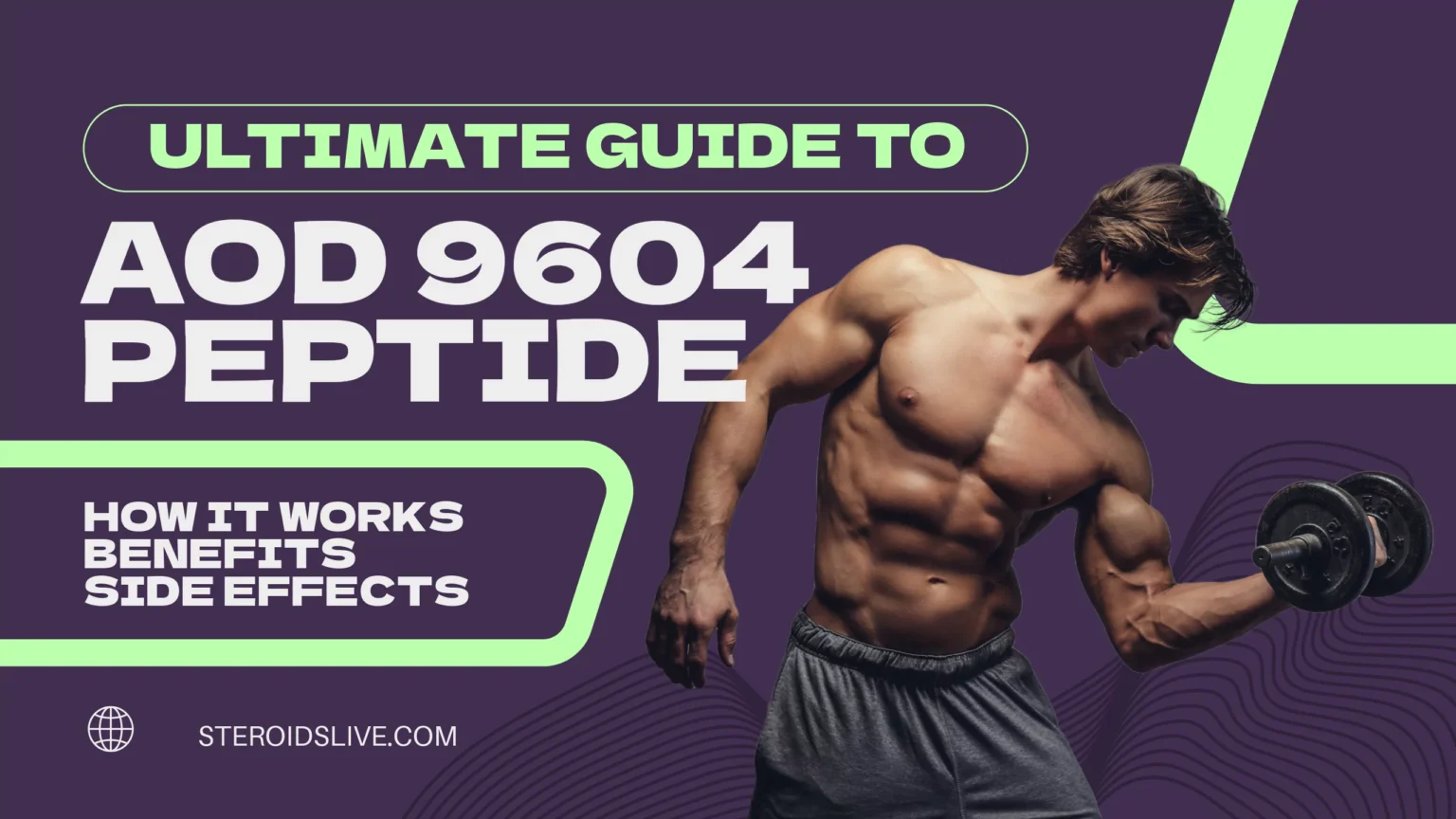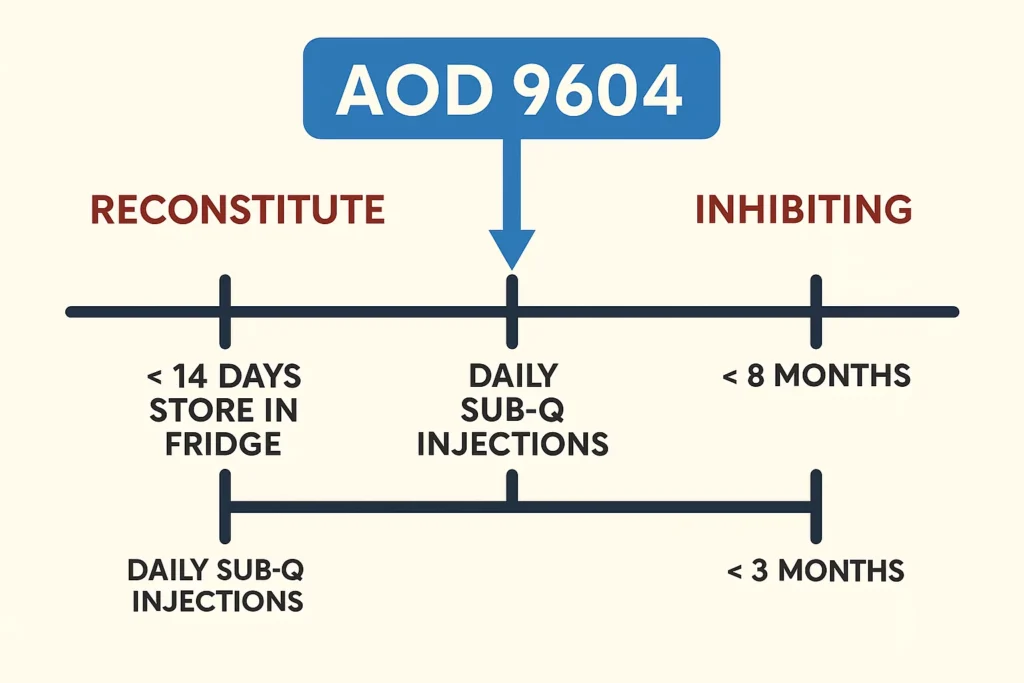In the quest for a metabolic edge, a research peptide called AOD 9604 has emerged from the labs, promising the fat-loss benefits of growth hormone without the downsides. But what does the science actually say? This isn’t your standard fat burner—we’re dissecting a precision-engineered fragment of Growth Hormone to see if it lives up to its potential for body composition and recovery.
What is AOD 9604? Decoding the “Blueprint”
AOD 9604 is a synthetic, modified version of the 176-191 segment of the Human Growth Hormone (HGH) molecule, first developed in the 1990s. Unlike full HGH, this fragment was specifically engineered to promote fat metabolism without influencing growth or insulin resistance—addressing the major concerns with traditional HGH use.
Important Note: AOD 9604 is currently classified as a research chemical and is not approved by the FDA for human consumption or as a therapeutic agent. It is available for “research purposes only” in laboratory settings.
The Mechanism: How AOD 9604 Works on a Cellular Level
To understand why AOD 9604 is so intriguing, we need to look at its dual-action mechanism at the cellular level.
The “Lipolytic Signal”
AOD 9604 mimics the part of HGH that signals fat cells (adipocytes) to break down stored triglycerides into free fatty acids—a process called lipolysis. This is the “fat burning” signal that mobilizes energy stores.
The “Anti-Lipogenic Blocker”
Perhaps more importantly, AOD 9604 blocks the enzyme (lipoprotein lipase) responsible for storing new fat in fat cells. This creates a two-pronged attack: it helps burn existing fat while preventing new fat storage.
The Critical Difference from HGH: If full HGH is a master key that unlocks every door in the body (growth, fat loss, blood sugar changes), AOD 9604 is a specially cut key that only unlocks the ‘fat loss’ door. It does not bind to the growth-promoting receptors that cause bone and organ growth.
Potential Benefits for Bodybuilders and Athletes: The Evidence
Targeted Fat Loss (Especially Stubborn Fat)
Theoretically, AOD 9604 may help mobilize fat from stubborn areas (lower abs, lower back) that are resistant to diet and exercise due to poor blood flow and high alpha-2 receptor density. However, the human trial data is mixed—some studies show promise while others show minimal effect beyond placebo.
According to a 2001 study published in Growth Hormone & IGF Research, the peptide demonstrated fat-reducing effects in obese patients, though more research is needed to confirm its efficacy in trained athletes.
Enhanced Recovery and Joint Repair
While not a growth agent, AOD 9604’s structural relation to HGH may contribute to stimulating collagen synthesis in cartilage and connective tissues. This could potentially lead to reduced joint pain and faster recovery from intense training—a highly valuable benefit for athletes pushing their limits.
This mechanism of action shares some similarities with other recovery peptides we’ve discussed in our article on Why Athletes Are Turning to Peptides for Injury Recovery.
Cartilage Protection and Injury Healing
Early research (primarily in vitro and animal studies) suggests AOD 9604 may stimulate chondrocyte (cartilage cell) production and promote the healing of joint injuries. A study in the Annals of Clinical & Laboratory Science Journal found it had a positive effect on cartilage metabolism, though human trials are needed to confirm these findings.

The Reality Check: Limitations and Contradictory Research
It’s crucial to address the clinical trials that failed to show significant fat loss benefits. A 2013 study in Clinical Endocrinology found no significant difference in fat loss between AOD 9604 and placebo groups over 12 weeks.
Potential reasons for these mixed results include variations in dosage, administration protocols, and the diet/training status of subjects. The effects may be more pronounced in individuals already in a caloric deficit and engaged in intense exercise, unlike some study populations.
The Verdict: The evidence for AOD 9604 is promising but not conclusive. Its effects appear to be more subtle than dramatic, and it should be viewed as a potential adjunct therapy rather than a primary fat loss solution.
AOD 9604 vs. Other Compounds: A Pragmatic Comparison
| Feature | AOD 9604 | Full HGH | Semaglutide (Ozempic/Wegovy) |
|---|---|---|---|
| Primary Mechanism | Direct fat cell signaling | Whole-body growth effects | Appetite suppression |
| Impact on Blood Sugar | Minimal to none | Can cause insulin resistance | Improves blood sugar control |
| Growth Effects | None | Significant (muscle, bone, organs) | None |
| Common Side Effects | Mild injection site reactions | Joint pain, water retention, carpal tunnel | GI issues, nausea |
| Legal Status | Research chemical | Prescription drug | Prescription drug |
The fundamental difference between AOD 9604 and semaglutide is their mechanism: semaglutide works by suppressing appetite and slowing gastric emptying, while AOD 9604 works directly on fat cells, independent of appetite. This positions AOD 9604 as a tool for those who already have their diet dialed in but need help with stubborn fat.
Side Effects and Safety Profile: What We Know and Don’t Know
In clinical studies, AOD 9604 has been generally well-tolerated with minimal side effects reported. The most common issues are mild injection site reactions such as redness or discomfort.
Due to its specific mechanism, it does not cause the common HGH side effects: no water retention, no joint pain, and no insulin disruption. However, the lack of long-term human safety data remains the biggest caveat.
Safety Note: Without long-term human studies, the complete safety profile of AOD 9604 remains unknown. Potential users should approach with caution and consult with healthcare professionals.
The Bodybuilder’s Protocol: Dosing, Timing, and Administration
Dosage Range
Typical research dosage ranges from 300mcg to 1mg (1000mcg) per day, often starting at the lower end to assess tolerance.
Optimal Timing
Often administered fasted in the morning to enhance lipid mobilization, and/or post-workout to leverage potential recovery benefits.
Administration
Typically delivered via subcutaneous injection after reconstitution from lyophilized (freeze-dried) powder.
Cycle Length
Research protocols often range from 8-12 weeks, followed by a break to assess results and prevent potential desensitization.
Critical Success Factor: AOD 9604 is NOT a substitute for a proper diet and training regimen. Like other supplements such as L-Carnitine, it should be viewed as a potential “finishing touch” during a cut, not a foundational tool. Its effects will be minimal without appropriate nutrition and exercise.
Conclusion: A High-Potential, Yet Unproven, Research Tool
AOD 9604 represents a fascinating step toward targeted metabolic manipulation. Its promise lies in its specific mechanism and clean side effect profile compared to full HGH. For the athlete or bodybuilder, it remains a speculative, albeit sophisticated, option that may offer a slight edge in shedding stubborn fat and aiding joint recovery.
However, it is far from a guaranteed or essential solution. The mixed clinical results and lack of long-term safety data mean it should be approached with cautious curiosity rather than high expectations. In the world of performance enhancement, AOD 9604 is an intriguing chapter in a still-unfolding story—one that requires more research to determine its true place in the athlete’s toolkit.



